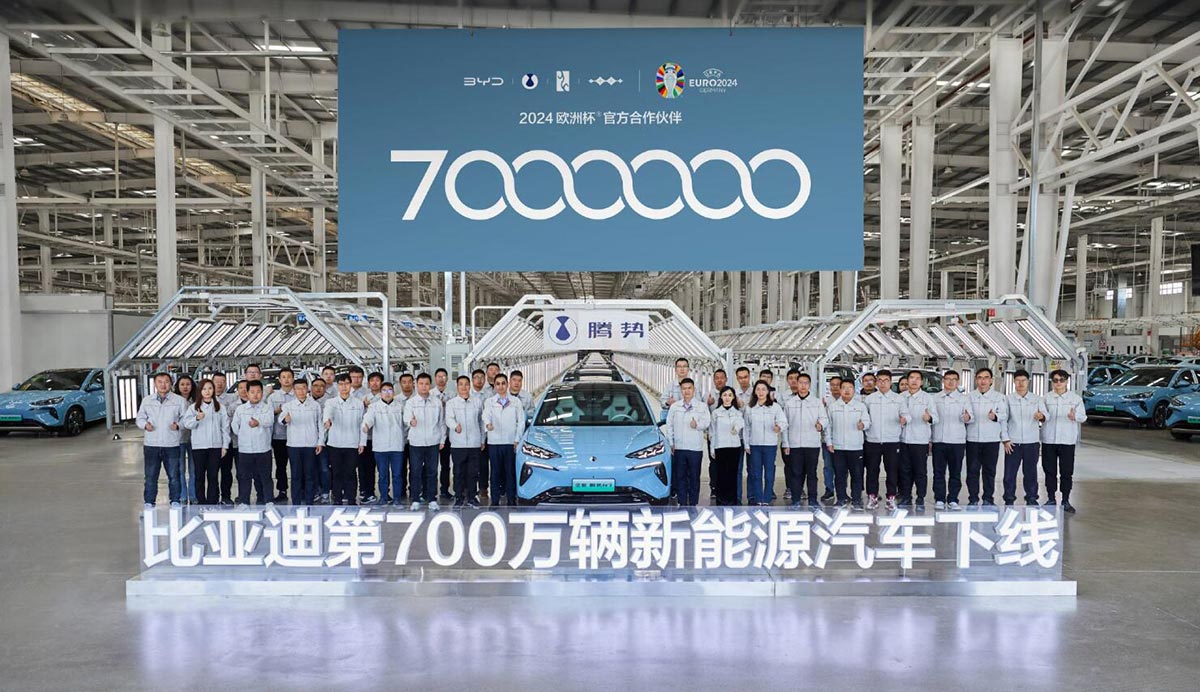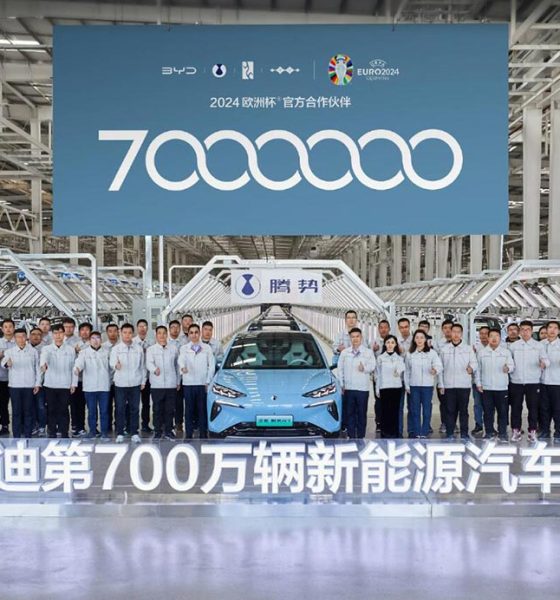BYD and other Chinese automakers have studied the European auto market for years. Now, it’s time to put their knowledge to the test and go all-in on the European auto market.
BYD’s strategy to take over Europe was recently revealed in a report by Reuters. The publication also shared details about how other Chinese automakers are entering the European market and their plans to beat top-selling brands like Tesla and Volkswagen in the EU’s local electric vehicle (EVs) market.
Below are the strategies BYD and Chinese automakers are implementing to deploy their vehicles in Europe.
- Understand European car consumers and their needs
- Improved marketing to increase brand awareness
- Expand dealership networks
- Build an extensive after-sales care service network, including improved service-and-repair operations.
- Protect resale values
The roads are buzzing with SUPER DM technology. The BYD SEAL U DM-i combines a range of more than 1000km with an attention to detail in every inch of its interior. It's the perfect synthesis of comfort and adventure.#BYD #BuildYourDreams #BYDSEALUDMi pic.twitter.com/gSNGtLzQV4— BYD Europe (@BYD_Europe) May 22, 2024
China Cars with Europeans in Mind
BYD and Chinese automakers have learned that adapting and importing cars from China to Europe is not enough. They have studied European car owners to understand the details they look for when purchasing a vehicle. As a result, some Chinese car brands have started designing cars from scratch for European buyers.
For instance, Chinese automakers have learned that safety ratings are important to European car owners, so they have improved their vehicles with safety as a priority.
“In China, the purchase price is important. But for European consumers, it’s not just price, but total cost of ownership, including maintenance, service, and residual values,” commented Bo Yu, JATO Dynamics’ Greater China Country Manager.
China-based car manufacturers are also strengthening and expanding repair-and-service operations to enhance after-sales care in Europe. Plus, they have started understanding the importance of resale values for European car owners.
“There are hard rules on issues like safety and that are clear, and then there are soft rules that aren’t written down. The Chinese are very eager to learn the soft rules,” said Ben Townsend, Head of Automotive at Thatcham.
Chinese Automakers’ Biggest Advantage
Electric vehicles have offered brands—both old and new—a chance to grow and expand in the transitioning auto market worldwide. Many automakers have not been phased by the EV market’s slowdown and are charging ahead in electric vehicle development. As such, EVs have become a good entry into the European market for China-based automakers.
Electric vehicles offer Chinese automakers one significant advantage in the global auto market: affordable prices.
China has also started to promote and grow its new energy vehicle (NEV) market, which includes battery electric vehicles (BEVs) and plug-in hybrid electric vehicles (PHEVs). The Chinese government financially supports local car companies through subsidies and its ever-expanding EV supply chain. China is ahead regarding battery-minerals mining, a critical part of the EV supply chain that affects costs.
The local government’s support has resulted in decreased EV prices, like the BYD Seagull, which is under $10,000 in China. The United States has tried to combat against Chinese EVs’ affordable prices by increasing import tariffs by 100%. Europe is expected to raise import tariffs for Chinese EV imports as well. However, the EU’s import tariffs might not be enough to dissuade consumers from affordable EV prices.
The BYD Seagull, for example, is expected to start below $20,000 in Europe even after EU tariffs. Volkswagen, one of Europe’s top car brands, doesn’t expect to launch an EV below €20,000 ($21,631) until 2027.
Equipped with a Europe-focused affordable EV, Chinese automakers have one more obstacle to tackle: brand awareness. BYD is already working on spreading its brand in Europe by participating in and funding local sporting events, like the Europe 2024 soccer championship. It is also working closely with local dealerships.
If you have any tips, contact me at maria@teslarati.com or via X @Writer_01001101.

News
Tesla China delivery centers look packed as 2025 comes to a close
Needless to say, it appears that Tesla China seems intent on ending 2025 on a strong note.

Tesla’s delivery centers in China seem to be absolutely packed as the final days of 2025 wind down, with photos on social media showing delivery locations being filled wall-to-wall with vehicles waiting for their new owners.
Needless to say, it appears that Tesla China seems intent on ending 2025 on a strong note.
Full delivery center hints at year-end demand surge
A recent image from a Chinese delivery center posted by industry watcher @Tslachan on X revealed rows upon rows of freshly prepared Model Y and Model 3 units, some of which were adorned with red bows and teddy bears. Some customers also seem to be looking over their vehicles with Tesla delivery staff.
The images hint at a strong year-end push to clear inventory and deliver as many vehicles as possible. Interestingly enough, several Model Y L vehicles could be seen in the photos, hinting at the demand for the extended wheelbase-six seat variant of the best-selling all-electric crossover.
Strong demand in China
Consumer demand for the Model Y and Model 3 in China seems to be quite notable. This could be inferred from the estimated delivery dates for the Model 3 and Model Y, which have been extended to February 2026 for several variants. Apart from this, the Model Y and Model 3 also continue to rank well in China’s premium EV segment.
From January to November alone, the Model Y took China’s number one spot in the RMB 200,000-RMB 300,000 segment for electric vehicles, selling 359,463 units. The Model 3 sedan took third place, selling 172,392. This is quite impressive considering that both the Model Y and Model 3 are still priced at a premium compared to some of their rivals, such as the Xiaomi SU7 and YU7.
With delivery centers in December being quite busy, it does seem like Tesla China will end the year on a strong note once more.
News
Tesla Giga Berlin draws “red line” over IG Metall union’s 35-hour week demands
Factory manager André Thierig has drawn a “red line” against reducing Giga Berlin’s workweek to 35 hours, while highlighting that Tesla has actually increased its workers’ salaries more substantially than other carmakers in the country.

Tesla Giga Berlin has found itself in a new labor dispute in Germany, where union IG Metall is pushing for adoption of a collective agreement to boost wages and implement changes, such as a 35-hour workweek.
In a comment, Giga Berlin manager André Thierig drew a “red line” against reducing Giga Berlin’s workweek to 35 hours, while highlighting that Tesla has actually increased its workers’ salaries more substantially than other carmakers in the country.
Tesla factory manager’s “red line”
Tesla Germany is expected to hold a works council election in 2026, which André Thierig considers very important. As per the Giga Berlin plant manager, Giga Berlin’s plant expansion plans might be put on hold if the election favors the union. He also spoke against some of the changes that IG Metall is seeking to implement in the factory, like a 35-hour week, as noted in an rbb24 report.
“The discussion about a 35-hour week is a red line for me. We will not cross it,” Theirig said.
“(The election) will determine whether we can continue our successful path in the future in an independent, flexible, and unbureaucratic manner. Personally, I cannot imagine that the decision-makers in the USA will continue to push ahead with the factory expansion if the election results favor IG Metall.”
Giga Berlin’s wage increase
IG Metall district manager Jan Otto told the German news agency DPA that without a collective agreement, Tesla’s wages remain significantly below levels at other German car factories. He noted the company excuses this by referencing its lowest pay grade, but added: “The two lowest pay grades are not even used in car factories.”
In response, Tesla noted that it has raised the wages of Gigafactory Berlin’s workers more than their German competitors. Thierig noted that with a collective agreement, Giga Berlin’s workers would have seen a 2% wage increase this year. But thanks to Tesla not being unionized, Gigafactory Berlin workers were able to receive a 4% increase, as noted in a CarUp report.
“There was a wage increase of 2% this year in the current collective agreement. Because we are in a different economic situation than the industry as a whole, we were able to double the wages – by 4%. Since production started, this corresponds to a wage increase of more than 25% in less than four years,” Thierig stated.
News
Tesla is seeing a lot of momentum from young Koreans in their 20s-30s: report
From January to November, young buyers purchased over 21,000 Teslas, putting it far ahead of fellow imported rivals like BMW and Mercedes-Benz.

Tesla has captured the hearts of South Korea’s 20s-30s demographic, emerging as the group’s top-selling imported car brand in 2025. From January to November, young buyers purchased over 21,000 Teslas, putting it far ahead of fellow imported rivals like BMW and Mercedes-Benz.
Industry experts cited by The Economist attributed this “Tesla frenzy” to fandom culture, where buyers prioritize the brand over traditional car attributes, similar to snapping up the latest iPhone.
Model Y dominates among young buyers
Data from the Korea Imported Automobile Association showed that Tesla sold 21,757 vehicles to the 20s-30s demographic through November, compared to BMW’s 13,666 and Mercedes-Benz’s 6,983. The Model Y led the list overwhelmingly, with variants like the standard and Long Range models topping purchases for both young men and women.
Young men bought around 16,000 Teslas, mostly Model Y (over 15,000 units), followed by Model 3. Young women followed a similar pattern, favoring Model Y (3,888 units) and Model 3 (1,083 units). The Cybertruck saw minimal sales in this group.
The Model Y’s appeal lies in its family-friendly SUV design, 400-500 km range, quick acceleration, and spacious cargo, which is ideal for commuting and leisure. The Model 3, on the other hand, serves as an accessible entry point with lower pricing, which is valuable considering the country’s EV subsidies.
The Tesla boom
Experts described Tesla’s popularity as “fandom culture,” where young buyers embrace the brand despite criticisms from skeptics. Professor Lee Ho-geun called Tesla a “typical early adopter brand,” comparing purchases to iPhones.
Professor Kim Pil-soo noted that young people view Tesla more as a gadget than a car, and they are likely drawn by marketing, subsidies, and perceived value. They also tend to overlook news of numerous recalls, which are mostly over-the-air software updates, and controversies tied to the company.
Tesla’s position as Korea’s top import for 2025 seems secured. As noted by the publication, Tesla’s December sales figures have not been reported yet, but market analysts have suggested that Tesla has all but secured the top spot among the country’s imported cars this year.










